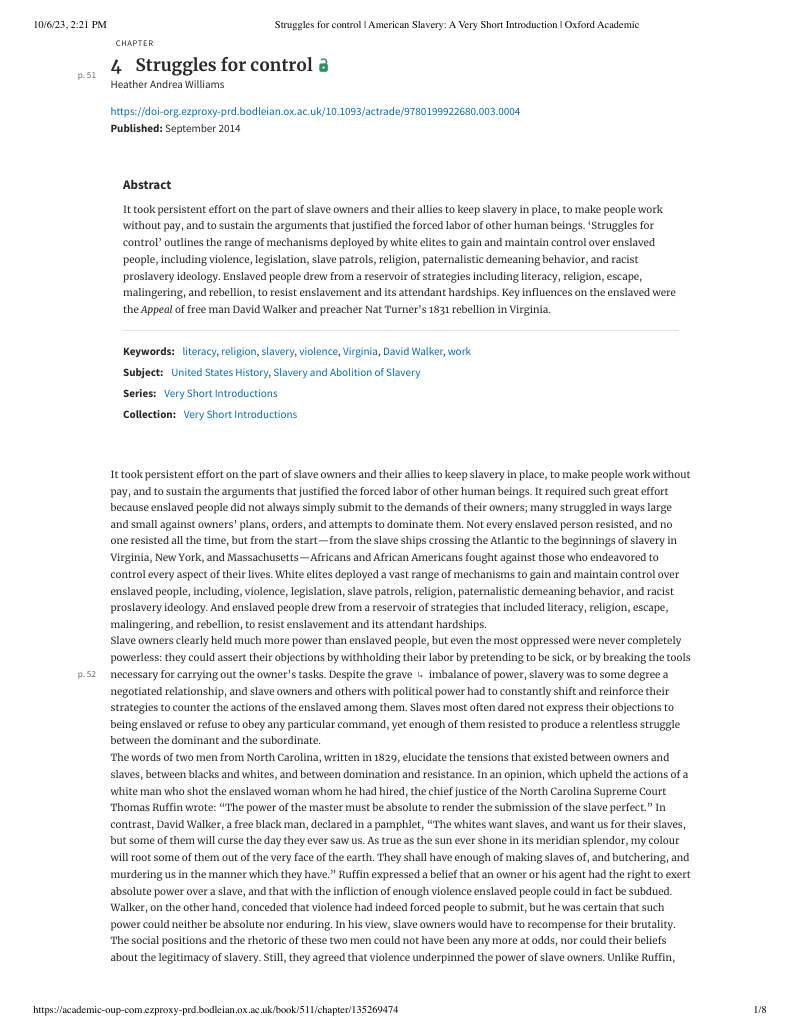Heather Andrea Williams describes how enslavers maintained control of slaves.
- Type
- Book
- Source
- Heather Andrea Williams Non-LDS
- Hearsay
- Secondary
- Reference
Heather Andrea Williams, "Struggles for Control," American Slavery: A Very Short Introduction (New York: Oxford Academic, 2014), 63-64
- Scribe/Publisher
- Oxford University Press
- People
- Heather Andrea Williams
- Audience
- Reading Public
- Transcription
Owners employed a mixture of violence and paternalism to keep the people they owned in their places of servility. Even as they exercised control, they also wanted to be perceived by both their slaves and outsiders as firm and caring masters with dominion over their slaves. Some planters paternalistically spoke of the people they owned as part of their large outside family, in contrast to their inside family that consisted of a wife and children. They said that they fed, clothed, and protected their slaves, and in return the slaves labored for them. In this schema, there should have been no need for violence, but despite some whites’ claims that enslaved people were servile by nature and perfectly suited to be slaves, and despite assertions that owners took good care of their slaves, most planters agreed with Justice Ruffin that violence was a necessary measure to extract labor and obedience from enslaved people.
Planters who could afford to employ help often distanced themselves from physical violence by delegating punishment to overseers or to jailers who punished other people’s slaves for a living. These owners sought to make a fine distinction between “correction” and “punishment,” sometimes urging their employees and delegates to administer whippings only for correction and prevention. They urged overseers not to administer punishment out of anger or with passion, as this would lead slaves to run away. Additionally, they thought that passion revealed a lack of control and that mastery demanded self-control. Owners also warned that punishment should not leave scars. Although expressed as emanating from a sense of concern about the slaves, this view was also in the owner’s self-interest: scars signaled to potential purchasers that this slave might be a troublemaker, therefore reducing his or her value in the market.
To avoid administering whippings, or when corporal punishment was not effective, owners employed a vast array of “corrections” and “punishments.” They locked people up at night; they denied passes to leave the plantation, a particularly painful punishment for men whose wives and children lived on other plantations. Despite all of their power, owners and overseers knew that their punishments might meet with resistance; “a violent and passionate threat,” one owner cautioned, “will often scare the best disposed negro to the woods.” Running to the woods was an undesirable consequence because this action deprived owners of the enslaved person’s labor. Timed well, the absence of even one slave could have serious consequences for an owner’s finances.
The B. H. Roberts Foundation is not owned by, operated by, or affiliated with the Church of Jesus Christ of Latter-day Saints.

